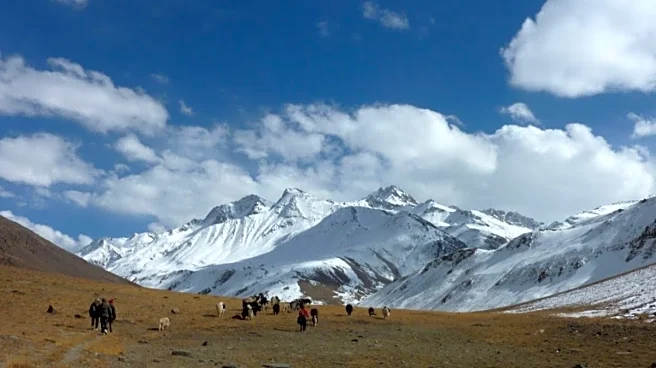A recent India-Afghanistan joint statement has acknowledged Wakhan as their contiguous neighbourhood. The Wakhan Corridor, a narrow, remote strip of land in Afghanistan’s Badakhshan Province, holds immense historical, geopolitical, and strategic significance, making it a critical, though indirect, factor in India-Afghanistan relations.
Formed as a buffer zone between the Russian and British Empires during the 19th-century “Great Game”, this rugged piece of territory connects Afghanistan to China while separating Tajikistan to the north from Pakistan to the south.
Geographical and Historical Context
The corridor is approximately 350 kilometres long, varying in width from 16 to 64 kilometres, and is bounded by the high peaks of the Pamir and Hindu Kush mountain ranges. Its eastern
tip shares a short, mountainous border (about 76 km) with China’s Xinjiang region, accessible via the high-altitude Wakhjir Pass, which is closed for much of the year.
Historically, this corridor was a vital tributary of the Ancient Silk Road, facilitating trade and cultural exchange between Central Asia, China, and the Indian subcontinent. However, its modern significance stems from its unique geographical position at the confluence of four nations: Afghanistan, Pakistan, China, and Tajikistan.
India’s Interest and Security Concerns
For India, the Wakhan Corridor is strategically important for two primary, intertwined reasons: connectivity to Central Asia and security concerns stemming from the influence of rivals.
Disputed Border and Sovereignty: India asserts that its border with Afghanistan runs through the Wakhan Corridor because of its claim over Gilgit-Baltistan, which is currently administered by Pakistan. This means India views the corridor as its contiguous neighbourhood, a claim recently reiterated in diplomatic statements. Maintaining a claim to this border indirectly strengthens India’s overall territorial position on Kashmir.
Containment of Rival Influence: India’s key interest is to counter the growing strategic convergence between China and Pakistan in the region. The corridor is seen as a potential route for the China-Pakistan Economic Corridor (CPEC) to extend into Central Asia. Any road or rail link developed through Wakhan would provide a shorter route for China into Afghanistan and for Pakistan to Central Asia, potentially isolating India’s own connectivity projects, such as the Chabahar Port in Iran, which aims to bypass Pakistan entirely to reach Afghanistan and Central Asia.
Security Implications: India is deeply concerned about the security implications of this region. The instability in Afghanistan, coupled with the potential for cross-border movement of militant groups into China’s Xinjiang or potentially towards India’s claimed border areas, remains a significant security threat. Chinese presence and military-security cooperation with the Taliban in this sensitive zone are closely monitored by India.
Impact on India-Afghanistan Relations
The Wakhan Corridor doesn’t directly connect India and Afghanistan at the moment, but it remains a crucial geostrategic fulcrum that shapes their bilateral engagement.
Connectivity Barrier: The corridor’s location next to Pakistan’s Gilgit-Baltistan region means it acts as a physical barrier preventing direct overland trade and strategic communication between India and Afghanistan, forcing India to rely on air corridors or the longer Chabahar route.
Strategic Bargaining Chip: Afghanistan, under the Taliban or any future government, sees the corridor as a political and economic bargaining chip. Cooperation with China and Pakistan on infrastructure development in Wakhan could provide economic aid but would also reduce Afghanistan’s reliance on India. Conversely, the importance of the corridor ensures that regional powers, including India, remain focused on the stability and geopolitical dynamics of Afghanistan.
In essence, the Wakhan Corridor is a relic of the past that remains a hotbed of current geopolitical rivalries. Its development, particularly by China and Pakistan, could redefine regional trade routes and the security balance, directly impacting India’s long-term strategic and economic interests in Afghanistan and Central Asia.





/images/ppid_a911dc6a-image-176183327335124810.webp)

/images/ppid_59c68470-image-176182252633663971.webp)

/images/ppid_59c68470-image-176180764086196139.webp)



/images/ppid_a911dc6a-image-176183322978185918.webp)

/images/ppid_a911dc6a-image-176183311735318282.webp)
